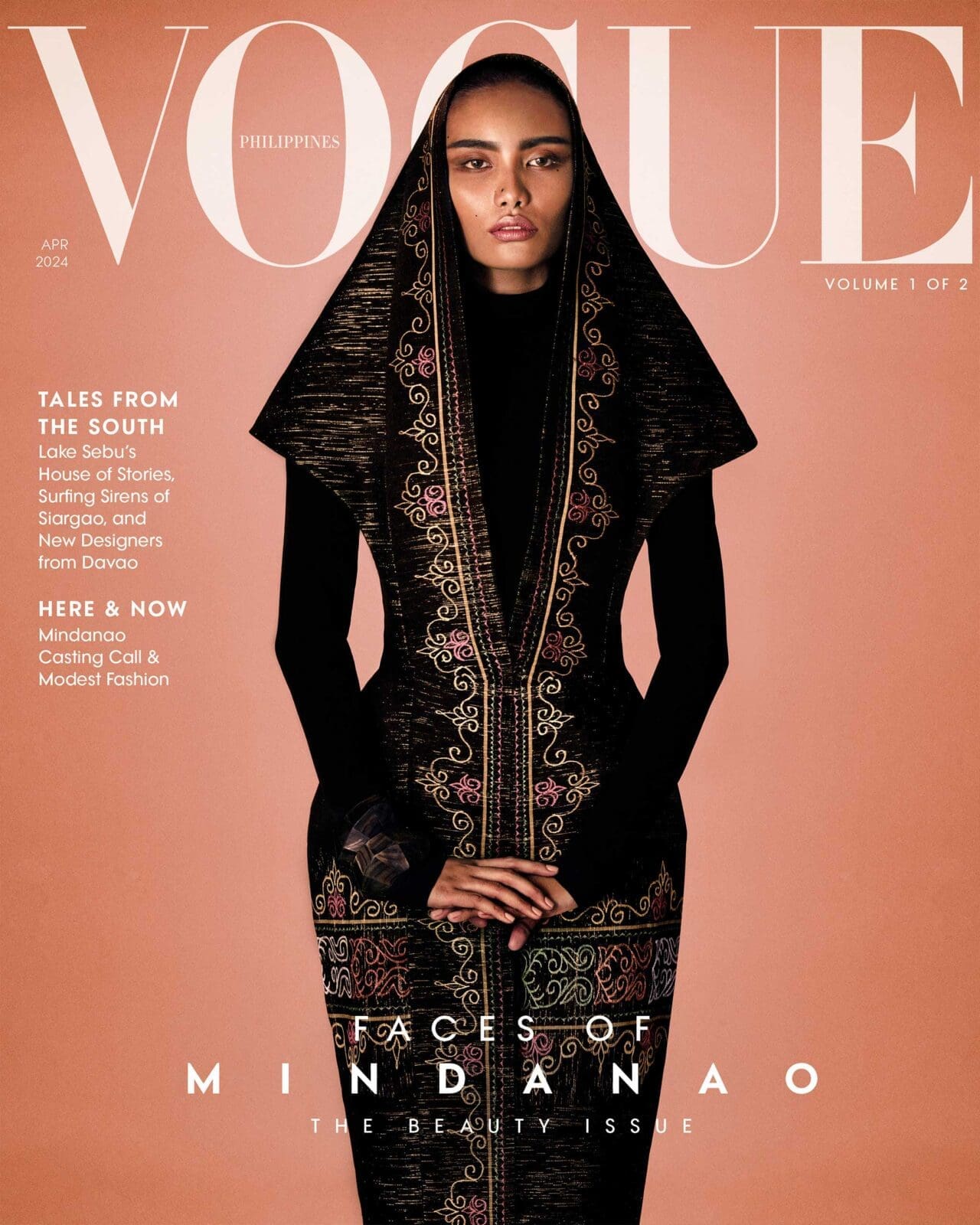Photographed by JOSEPH BERMUDEZ for the April 2024 Issue of Vogue Philippines
As a designer, Steffy Misoles-Dacalus has mastered the art of creating with indigenous textiles, combining them with materials from Luzon, Visayas, and Mindanao.
Like many children who came of age before the internet, Steffy Misoles-Dacalus spent most of her days outside. “Playing in the mud, in the rain, with the boys,” she recalls. On the off-chance that she was indoors, the eldest of six siblings would play with paper dolls, mixing and matching their cut-up clothes. When one of her sisters finally owned a Barbie doll later on, Steffy took to replacing its outfits with garments she made herself, by puncturing holes in her own socks or hand-sewing fabric scraps found at home.
By the time Steffy was in college, she was certain that she wanted to become a designer. “I knew I had this creativity wherein I could fully express myself if I would explore fashion,” she recalls. However, her parents, who she describes as “traditional,” urged her to take up accounting with the goal of becoming an entrepreneur. The young creative was vehemently opposed to the idea: “I loathe math, it’s just a lot of work. Anything that has to be measured, my brain would go haywire.”

Despite acceptance into the program, she enrolled in sociology on the sole basis that its curriculum only included two math courses. She promised her father that she would shift to accounting after her sophomore year. “Wala talagang shift na nangyari! [There was no shift that happened!]” she reveals with a laugh.
Still, she remained adamant about her dream career. Intending to build the foundations toward it Steffy took modeling jobs while still completing her degree. “I got sidetracked because I wanted to work with designers,” she says. By shadowing them, she gathered insights on their processes, which she eventually supplemented with a year-long basic dressmaking course after graduation. It’s what allowed her to venture into ready-to-wear in 2012, when she began designing and manufacturing uniforms for corporate clients.
It’s not exactly what she had in mind. After all, she was an avant-gardist who looked up to Alexander McQueen and John Galliano, masters of irreverent experimentation. The itch to fully wield her creativity drove her to participate in her first fashion show, an ancillary event for the Miss Universe pageant in 2017.
“Her brand has branched out to all
three major islands—her shoes are
manufactured in Marikina, components for her footwear
(including mother-of-pearl)
are sourced from Cebu, and a
majority of indigenous weaves and
production of all clothing are proudly based in Mindanao.”
A few months later, she was invited to show at the Canada leg of Kadayawan Weave: Haute Culture, a fashion show series established by the Davao Fashion Design Council with the support of the Davao City Government, City Tourism Operations Office, and Department of Tourism. It was then that she first used Tnalak, a textile handwoven by weavers from the indigenous Tboli community from Lake Sebu.
Her appreciation for indigenous textiles grew, and she soon found herself seeking crafts from all over the Philippines. Over time, she developed a knowledge for the best executions for certain weaves. For instance, the stiffness of Tnalak makes it best for crafting bags, and it’s the same with the Yakan textiles from Zamboanga. For shoes, she loves to work with Pis Siyabit woven by the Tausug in Sulu, and for clothes, she gravitates toward Inaul from Maguindanao’s Iranon community.
As a traveler, she enjoyed visiting the communities in Lake Sebu herself to pick up the fabric, but has since shifted to remote sourcing due to a limited team. At the moment, she’s in charge of designing the garments and overseeing all operations. But because she loves the job, it doesn’t feel like work. “It’s more of showcasing what Luzon, Visayas, and Mindanao has to offer,” she explains. Her brand has branched out to all three major islands—her shoes are manufactured in Marikina, components for her footwear (including mother-of-pearl) are sourced from Cebu, and a majority of indigenous weaves and production of all clothing are proudly based in Mindanao.

Steffy has whittled down her in-house team to one trusted seamstress. She’s taking it very slowly, but she’s relishing that; she’s at a point in her life where she wants to move things forward at her own pace. She only takes two-three bespoke commissions at a time, and even then her clients are those she already has relationships with. At this stage in her life, nothing is more important to her than family. Her brand, Steffy de Mylo, is a combination of her name and her son’s after all.
Her days have mellowed. She’s traded hours in the studio for drives with her son to and from school and swim practice afterward. On the weekends, she makes the drive out of the city and to her childhood, where she visits her mother and cooks for the family. “It’s like I never left home,” she sighs. “I am big on family, I wouldn’t go elsewhere to find my happiness. Wala na akong hahanap-hanapin pa [There’s nothing else I’m searching for].”
Words & Styling by TICIA ALMAZAN Photographs by JOSEPH BERMUDEZ. Makeup & Hair: Goldie Siglos. Model: Ivanna Lagman. Photographer’s Assistants: Adi De Gracia, Ellah Plariza. Stylist’s Assistant: Patricia Villoria. Shot on location at Dusit Thani Lubi Plantation Resort.

